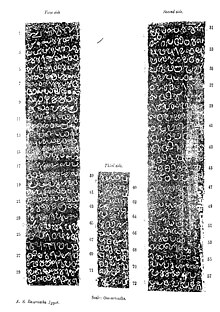| Rama Kulasekhara | |
|---|---|
| Kulasekhara Perumal • Koyil Adhikarikal • Cheraman Perumal • Cheramanar (Tamil) • Chakravarthikal ("Ma Ko") • Thiruvadi | |
 Perunna temple inscription (1099 AD) | |
| King of Chera Perumal Kingdom | |
| Reign | 1089/90–c.1122/23 AD[1] |
| Predecessor | Adithya Goda "Ranadithya"[1] (c. 1036–1089 CE)[2] |
| Successor | Vira Kerala[3] |
| Issue | Vira Kerala[3] |
| House | Chera Perumal dynasty |
Rama Kulasekhara (fl. late 11th century CE[4]) was the last ruler of the Chera Perumal dynasty of medieval Kerala.[5][6] He was a contemporary to Chola kings Kulottunga I (1070–1120) and Vikrama Chola (1118–35 AD).[6] Rama Kulaskehara is best known for briefly recovering Kollam-Trivandrum-Nagercoil region from the powerful Chola empire around 1100/02 AD.[6]
Inscriptions related to Rama Kulasekhara can be found at Panthalayani Kollam near Quilandy, Thiruvaloor (on Periyar), Perunna near Changanassery, Nedumpuram Thali (Wadakkanchery) and at Kollam.[7] Weakened authority of the Chera Perumal is evident in some of the inscriptions of Rama Kulasekhara. In 1099 AD, the leader of the Nair warriors of Nedumpurayur Nadu is seen handling the affairs of the Nedumpuram Thali, a state-sponsored temple.[8] In 1102 AD, Rama Kulasekhara publicly atoned for the wrongs committed by him against the Brahmin community.[8] An inscription dated to 1122 AD, found at Thiruvalanchuzhi, Tanjore (dated in the regnal year of king Vikrama Chola), also remembers Rama Kulasekhara.[7]
Kollam functioned as the second headquarters of the Chera Perumal kingdom towards the final phase of Rama Kulasekhara's rule (c. 1100/02 AD - c. 1122/23). According to scholars, "the strategic advantage of marriage relations with the old ruling clan of Kollam in securing the loyalty of Venad can also be considered in the light of continuous Chola-Pandya attacks in south Kerala".[9] There is a tradition that Vira Kerala, a ruler of Kollam in early 12th century, was a son of the last Chera king.[10]
- ^ a b Devadevan, Manu V. (2020). "Changes in Land Relations and the Changing Fortunes of the Cera State". The 'Early Medieval' Origins of India. Cambridge University Press. p. 122. ISBN 9781108857871.
- ^ As per M. G. S. Narayanan (1972)
- ^ a b Narayanan, M. G. S. (2013) [1972]. Perumāḷs of Kerala. Thrissur (Kerala): CosmoBooks. p. 86. ISBN 9788188765072.
- ^ Narayanan, M. G. S. (2002). "The State in the Era of the Ceraman Perumals of Kerala". In Champakalakshmi, R.; Veluthat, Kesavan; Venugopalan, T. R. (eds.). State and Society in Premodern South India. Thrissur (Kerala): CosmoBooks. pp. 111–19.
- ^ Devadevan, Manu V. (2020). "Changes in Land Relations and the Changing Fortunes of the Cera State". The 'Early Medieval' Origins of India. Cambridge University Press. p. 121. ISBN 9781108857871.
- ^ a b c Narayanan, M. G. S. (2013) [1972]. Perumāḷs of Kerala. Thrissur (Kerala): CosmoBooks. pp. 125–130. ISBN 9788188765072.
- ^ a b Narayanan, M. G. S. (2013) [1972]. Perumāḷs of Kerala. Thrissur (Kerala): CosmoBooks. pp. 20, 125–130, 467–470. ISBN 9788188765072.
- ^ a b Devadevan, Manu V. (2020). "Changes in Land Relations and the Changing Fortunes of the Cēra State". The 'Early Medieval' Origins of India. Cambridge University Press. p. 149. ISBN 9781108494571.
- ^ Narayanan, M. G. S. (2013) [1972]. Perumāḷs of Kerala. Thrissur (Kerala): CosmoBooks. p. 154. ISBN 9788188765072.
- ^ Narayanan, M. G. S. (2013) [1972]. Perumāḷs of Kerala. Thrissur (Kerala): CosmoBooks. p. 171. ISBN 9788188765072.